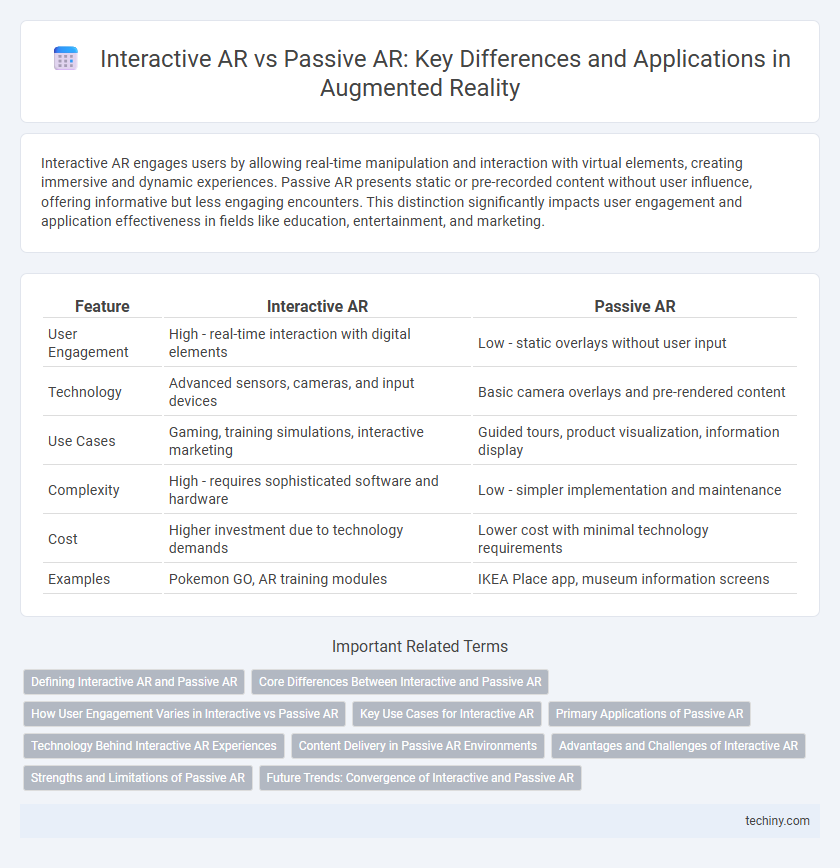Interactive AR engages users by allowing real-time manipulation and interaction with virtual elements, creating immersive and dynamic experiences. Passive AR presents static or pre-recorded content without user influence, offering informative but less engaging encounters. This distinction significantly impacts user engagement and application effectiveness in fields like education, entertainment, and marketing.
Table of Comparison
| Feature | Interactive AR | Passive AR |
|---|---|---|
| User Engagement | High - real-time interaction with digital elements | Low - static overlays without user input |
| Technology | Advanced sensors, cameras, and input devices | Basic camera overlays and pre-rendered content |
| Use Cases | Gaming, training simulations, interactive marketing | Guided tours, product visualization, information display |
| Complexity | High - requires sophisticated software and hardware | Low - simpler implementation and maintenance |
| Cost | Higher investment due to technology demands | Lower cost with minimal technology requirements |
| Examples | Pokemon GO, AR training modules | IKEA Place app, museum information screens |
Defining Interactive AR and Passive AR
Interactive Augmented Reality (AR) enables users to engage dynamically with digital elements in real-time, often through gestures, voice commands, or device sensors, creating immersive and responsive experiences. Passive AR, in contrast, overlays static or pre-programmed digital content onto the real world without user interaction, serving primarily as a visual enhancement or informational display. Understanding the distinction between Interactive AR and Passive AR is essential for developing applications that either prioritize user engagement or straightforward content presentation.
Core Differences Between Interactive and Passive AR
Interactive AR integrates user inputs such as gestures, voice commands, or touch to create dynamic, real-time engagement with digital content, enhancing immersion and usability in applications like gaming and training. Passive AR, by contrast, overlays static or pre-recorded digital elements onto the real world without user interaction, often used in advertising or information display where the content remains unchanged based on user behavior. The core difference lies in interactivity: Interactive AR responds to user actions, altering the experience, while Passive AR delivers a fixed visual layer independent of user involvement.
How User Engagement Varies in Interactive vs Passive AR
User engagement in Interactive Augmented Reality (AR) significantly surpasses that of Passive AR as it allows users to actively manipulate virtual elements, fostering immersive experiences and personalized interactions. In contrast, Passive AR primarily delivers static or pre-recorded content, limiting the depth of user participation and real-time feedback. This dynamic interaction in Interactive AR enhances cognitive involvement and retention, making it a preferred choice in education, gaming, and marketing applications.
Key Use Cases for Interactive AR
Interactive Augmented Reality enhances user engagement by overlaying dynamic digital content that responds to real-time inputs, enabling applications such as immersive retail experiences, interactive gaming, and hands-on training simulations. Key use cases include virtual try-ons in fashion and eyewear, interactive museum exhibits that provide contextual information, and augmented maintenance guides in manufacturing that allow workers to visualize complex instructions. These applications leverage interactive AR's capability to blend digital interactivity with physical environments, creating more intuitive and productive user experiences.
Primary Applications of Passive AR
Passive Augmented Reality (AR) primarily serves applications in retail display, museum exhibits, and real estate visualization by overlaying static digital content onto real-world environments without user interaction. This form of AR enhances user experience through contextual information, such as product details or historical data, displayed via smartphones or AR glasses. Passive AR enables seamless consumer engagement and informational enrichment, driving increased retention and decision-making efficiency.
Technology Behind Interactive AR Experiences
Interactive Augmented Reality leverages advanced computer vision, real-time data processing, and sensor fusion technologies to enable user engagement and dynamic content manipulation. Unlike Passive AR, which primarily overlays static digital elements, Interactive AR employs spatial mapping, gesture recognition, and machine learning algorithms to create immersive and responsive environments. These technological components collectively enhance user interaction, making AR experiences more intuitive and context-aware.
Content Delivery in Passive AR Environments
Passive AR environments deliver content through fixed visual overlays, providing users with information without requiring interaction. This non-interactive approach enhances user experience by seamlessly integrating digital elements into the real world, often used in advertising, wayfinding, or informational displays. Content delivery in Passive AR prioritizes clarity and immediacy, ensuring that users receive essential data quickly and effortlessly.
Advantages and Challenges of Interactive AR
Interactive Augmented Reality (AR) enhances user engagement through real-time interaction with virtual objects, improving learning, training, and gaming experiences by fostering active participation. Key advantages include personalized content adaptation and increased immersion, which lead to higher retention rates and user satisfaction compared to Passive AR, which only overlays static information. Challenges of Interactive AR involve high development costs, the need for advanced hardware, and potential user interface complexity that can hinder accessibility and widespread adoption.
Strengths and Limitations of Passive AR
Passive AR excels in simplicity and minimal hardware requirements, enabling easy integration into mobile devices without demanding significant processing power. Its limitations include lack of real-time user interaction and limited adaptability to changing environments, reducing immersive experiences compared to Interactive AR. Despite these constraints, Passive AR remains effective for applications like static overlays and informational displays where user input is minimal.
Future Trends: Convergence of Interactive and Passive AR
Future trends in augmented reality indicate a convergence of interactive AR, which enables real-time user engagement through gesture and voice recognition, with passive AR, characterized by pre-rendered, context-aware content delivery. This fusion aims to create seamless, immersive experiences by integrating dynamic user inputs with adaptive environmental overlays, enhancing applications in education, retail, and healthcare. Advancements in AI-driven computer vision and 5G connectivity are pivotal in accelerating this integration, promising more intuitive and responsive AR ecosystems.
Interactive AR vs Passive AR Infographic

 techiny.com
techiny.com